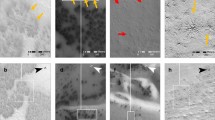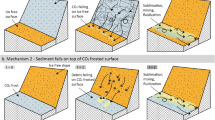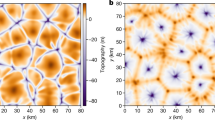Abstract
Martian gully landforms resemble terrestrial debris flows formed by the action of liquid water and have thus been interpreted as evidence for potential habitable environments on Mars within the past few millennia. However, ongoing gully formation has been detected under surface conditions much too cold for liquid water, but at times in the martian year when a thin layer of seasonal CO2 frost is present and defrosting above the regolith. These observations suggest that the CO2 condensation–sublimation cycle could play a role in gully formation. Here we use a thermo-physical numerical model of the martian regolith underlying a CO2 ice layer and atmosphere to show that the pores beneath the ice layer can be filled with CO2 ice and subjected to extreme pressure variations during the defrosting season. The subsequent gas fluxes can destabilize the regolith material and induce gas-lubricated debris flows with geomorphic characteristics similar to martian gullies. Moreover, we find that subsurface CO2 ice condensation, sublimation and pressurization occurs at conditions found at latitudes and slope orientations where gullies are observed. We conclude that martian gullies can result from geologic dry ice processes that have no terrestrial analogues and do not require liquid water. Such dry ice processes may have helped shape the evolution of landforms elsewhere on the martian surface.
This is a preview of subscription content, access via your institution
Access options
Subscribe to this journal
Receive 12 print issues and online access
$259.00 per year
only $21.58 per issue
Buy this article
- Purchase on Springer Link
- Instant access to full article PDF
Prices may be subject to local taxes which are calculated during checkout




Similar content being viewed by others
References
Malin, M. C. & Edgett, K. S. Evidence for recent groundwater seepage and surface runoff on Mars. Science 288, 2330–2335 (2000).
Mangold, N., Costard, F. & Forget, F. Debris flows over sand dunes on Mars: evidence for liquid water. J. Geophys. Res. 108, 5027 (2003).
Balme, M. et al. Orientation and distribution of recent gullies in the southern hemisphere of Mars: observations from High Resolution Stereo Camera/Mars Express (HRSC/MEX) and Mars Orbiter Camera/Mars Global Surveyor (MOC/MGS) data. J. Geophys. Res. 111, E05001 (2006).
Costard, F., Forget, F., Mangold, N. & Peulvast, J. P. Formation of recent martian debris flows by melting of near-surface ground ice at high obliquity. Science 295, 110–113 (2002).
Harrison, T. N., Osinski, G. R., Tornabene, L. L. & Jones, E. Global documentation of gullies with the Mars Reconnaissance Orbiter Context Camera (CTX) and implications for their formation. Icarus 252, 236–254 (2015).
Mellon, M. T. & Phillips, R. J. Recent gullies on Mars and the source of liquid water. J. Geophys. Res. 106, 23165–23180 (2001).
Dundas, C. M., Diniega, S., Hansen, C. J., Byrne, S. & McEwen, A. S. Seasonal activity and morphological changes in martian gullies. Icarus 220, 124–143 (2012).
Dundas, C. M., Diniega, S. & McEwen, A. S. Long-term monitoring of martian gully formation and evolution with MRO/HiRISE. Icarus 251, 244–263 (2015).
Dundas, C. M., McEwen, A. S., Diniega, S., Byrne, S. & Martinez-Alonso, S. New and recent gully activity on Mars as seen by HiRISE. Geophys. Res. Lett. 37, L07202 (2010).
Reiss, D., Erkeling, G., Bauch, K. E. & Hiesinger, H. Evidence for present day gully activity on the Russell crater dune field, Mars. Geophys. Res. Lett. 37, L06203 (2010).
Hansen, C. J. et al. Seasonal erosion and restoration of Mars’ northern polar dunes. Science 331, 575–578 (2011).
Hoffman, N. Active polar gullies on Mars and the role of carbon dioxide. Astrobiology 2, 313–323 (2002).
Cedillo-Flores, Y., Treiman, A. H., Lassue, J. & Clifford, S. M. CO2 gas fluidization in the initiation and formation of martian polar gullies. Geophys. Res. Lett. 38, L21202 (2011).
Pilorget, C., Edwards, C. S., Ehlmann, B. E., Forget, F. & Millour, E. Material ejection by the cold jets and temperature evolution of the south seasonal polar cap of Mars from THEMIS/CRISM observations and implications for surface properties. J. Geophys. Res. 118, 2520–2536 (2013).
Stewart, S. T. & Nimmo, F. Surface runoff features on Mars: testing the carbon dioxide formation hypothesis. J. Geophys. Res. 107, 5069 (2002).
Diniega, S. et al. A new dry hypothesis for the formation of martian linear gullies. Icarus 225, 526–537 (2013).
Forget, F. et al. Improved general circulation models of the martian atmosphere from the surface to above 80 km. J. Geophys. Res. 104, 24155–24176 (1999).
Pilorget, C., Forget, F., Millour, E., Vincendon, M. & Madeleine, J. B. Dark spots and cold jets in the polar regions of Mars: new clues from a thermal model of surface CO2 ice. Icarus 213, 131–149 (2011).
Aharonson, O. & Schorghofer, N. Subsurface ice on Mars with rough topography. J. Geophys. Res. 111, E11007 (2006).
Reiss, D. & Jaumann, R. Recent debris flows on Mars: seasonal observations of the Russell crater dune field. Geophys. Res. Lett. 30, 1321 (2003).
Gardin, E., Allemand, P., Quantin, C. & Thollot, P. Defrosting, dark flow features, and dune activity on Mars: example in Russell crater. J. Geophys. Res. 115, E06016 (2010).
Jouannic, G. et al. Morphological and mechanical characterization of gullies in a periglacial environment: the case of the Russell crater dune (Mars). Planet. Space Sci. 71, 38–54 (2012).
Kieffer, H. H., Christensen, P. R. & Titus, T. N. CO2 jets formed by sublimation beneath translucent slab ice in Mars’ seasonal south polar ice cap. Nature 442, 793–796 (2006).
Félix, G. & Thomas, N. Relation between dry granular flow regimes and morphology of deposits: formation of levées in pyroclastic deposits. Earth Planet. Sci. Lett. 221, 197–213 (2004).
Ishida, M., Hatano, H. & Shirai, T. The flow of solid particles in an aerated inclined channel. Powder Technol. 27, 7–12 (1980).
Schügerl, K. Fluidization (eds Davidson, J. F. & Harrison, D.) 261–292 (Academic, 1971).
Mangold, N. et al. Sinuous gullies on Mars: frequency, distribution, and implications for flow properties. J. Geophys. Res. 115, E11001 (2010).
Thomas, N., Hansen, C. J., Portyankina, G. & Russell, P. S. HiRISE observations of gas sublimation-driven activity in Mars’ southern polar regions: II. Surficial deposits and their origins. Icarus 205, 296–310 (2010).
Roche, O. et al. Dynamic pore-pressure variations induce substrate erosion by pyroclastic flows. Geology 41, 1107–1110 (2013).
Laskar, J. et al. Long term evolution and chaotic diffusion of the insolation quantities of Mars. Icarus 170, 343–364 (2004).
Kreslavsky, M. A. & Head, J. W. Kilometer-scale roughness of Mars: results from MOLA data analysis. J. Geophys. Res. 105, 26695–26712 (2000).
Kreslavsky, M. A. & Head, J. W. North-south topographic slope asymmetry on Mars: evidence for insolation-related erosion at high obliquity. Geophys. Res. Lett. 30, 1815 (2003).
Piqueux, S. & Christensen, P. R. North and south subice gas flow and venting of the seasonal caps of Mars: a major geomorphological agent. J. Geophys. Res. 113, E06005 (2008).
Hansen, C. J. et al. Observations of the northern seasonal polar cap on Mars: I. Spring sublimation activity and processes. Icarus 225, 881–897 (2013).
Conway, S. J. & Balme, M. R. Decameter thick remnant glacial ice deposits on Mars. Geophys. Res. Lett. 41, 5402–5409 (2014).
Toon, O. B., McKay, C. P., Ackerman, T. P. & Santhanam, K. Rapid calculation of radiative heating rates and photodissociation rates in inhomogeneous multiple scattering atmospheres. J. Geophys. Res. 94, 16287–16301 (1989).
Ockert-Bell, M. E., Bell, J. F., Pollack, J. B., McKay, C. P. & Forget, F. Absorption and scattering properties of the martian dust in the solar wavelengths. J. Geophys. Res. 102, 9039–9050 (1997).
Spiga, A. & Forget, F. Fast and accurate estimation of solar irradiance on martian slopes. Geophys. Res. Lett. 35, L15201 (2008).
Hapke, B. W., Shepard, M. K., Nelson, R. M., Smythe, W. D. & Piatek, J. L. A quantitative test of the ability of models based on the equation of radiative transfer to predict the bidirectional reflectance of a well-characterized medium. Icarus 199, 210–218 (2009).
Kieffer, H. H. Cold jets in the martian polar caps. J. Geophys. Res. 112, E08005 (2007).
Schubert, G., Solomon, S. C., Turcotte, D. L., Drake, M. J. & Sleep, N. H. in Mars (eds Keiffer, H. H., Jakosky, B. M., Snyder, C. W. & Matthews, M. S.) 147–183 (Univ. Arizona Press, 1992).
Hourdin, F., Le Van, P., Forget, F. & Talagrand, O. Meteorological variability and the annual surface pressure cycle on Mars. J. Atmos. Sci. 50, 3625–3640 (1993).
James, P. B., Kieffer, H. H. & Paige, D. A. in Mars (eds Keiffer, H. H., Jakosky, B. M., Snyder, C. W. & Matthews, M. S.) 934–960 (Univ. Arizona Press, 1992).
Atwood-Stone, C. & McEwen, A. S. Avalanche slope angles in low-gravity environments from active martian sand dunes. Geophys. Res. Lett. 40, 2929–2934 (2013).
Eames, I. & Gilbertson, M. A. Aerated granular flow over a horizontal rigid surface. J. Fluid Mech. 424, 169–195 (2000).
Jop, P., Forterre, Y. & Pouliquen, O. A constitutive law for dense granular flows. Nature 441, 727–730 (2006).
Jessop, D. E. et al. LiDAR derived morphology of the 1993 Lascar pyroclastic flow deposits, and implication for flow dynamics and rheology. J. Volcanol. Geotherm. Res. 245–246, 81–97 (2012).
Acknowledgements
We would like to thank A. Mangeney, M. Vincendon, P.-Y. Meslin and L. Kerber for fruitful discussions about this work. We are also grateful to our colleagues at Caltech, IAS and LMD for inspiration and advice. C.P. acknowledges partial support from NNX14AG54G and CNES. Finally, we thank C. Dundas for constructive comments.
Author information
Authors and Affiliations
Contributions
C.P. and F.F. developed the model and wrote the manuscript. C.P. run the simulations and performed the analyses.
Corresponding author
Ethics declarations
Competing interests
The authors declare no competing financial interests.
Supplementary information
Supplementary Information
Supplementary Information (PDF 1005 kb)
Rights and permissions
About this article
Cite this article
Pilorget, C., Forget, F. Formation of gullies on Mars by debris flows triggered by CO2 sublimation. Nature Geosci 9, 65–69 (2016). https://doi.org/10.1038/ngeo2619
Received:
Accepted:
Published:
Issue Date:
DOI: https://doi.org/10.1038/ngeo2619
This article is cited by
-
Mars and the ESA Science Programme - the case for Mars polar science
Experimental Astronomy (2022)
-
Image Simulation and Assessment of the Colour and Spatial Capabilities of the Colour and Stereo Surface Imaging System (CaSSIS) on the ExoMars Trace Gas Orbiter
Space Science Reviews (2018)
-
Experiments On Sublimating Carbon Dioxide Ice And Implications For Contemporary Surface Processes On Mars
Scientific Reports (2017)
-
Mars on dry ice
Nature Geoscience (2016)
-
Mars: a small terrestrial planet
The Astronomy and Astrophysics Review (2016)



